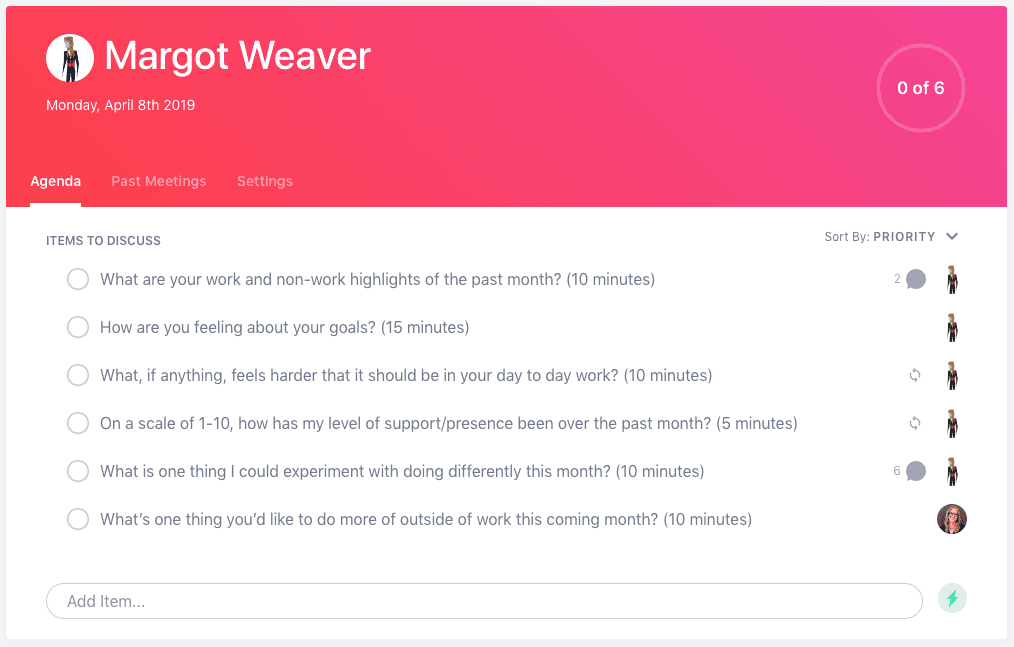The only monthly one-on-one meeting agenda template you’ll ever need
While some managers like their one-on-ones to happen weekly, others prefer a longer one-on-one on a monthly basis. Switching to…
Warning: Undefined array key "category" in /www/hypercontext_216/public/wp-content/themes/Soapbox/hype-files/sections/article/content.php on line 10
While some managers like their one-on-ones to happen weekly, others prefer a longer one-on-one on a monthly basis. Switching to a monthly frequency lets you have deeper conversations, but it also requires a slightly different one-on-one meeting agenda.
With that in mind, here’s a 60-minute one-on-one meeting template developed specifically for monthly meetings.
Click here to jump to see the Hypercontext monthly one-on-one meeting template in action!
1. What are your work and non-work highlights of the past month? (10 minutes)
A lot can happen in a month. Starting off with a check-in on their work life, their personal life and their overall happiness is essential – it will help determine the main focus of the rest of your time together. Make sure to ask truly listen to the answer you get back, and, if needed, push them beyond the stock answers.
2. How are you feeling about your goals? (15 minutes)
Ideally, you’ll have access to a shared source (a PM tool, a Google Doc, etc.) where the team’s collective and individual goals are tracked. But sometimes numbers only tell half the story. Getting the qualitative details that go with the quantitative data is essential.
3. What, if anything, feels harder that it should be in your day to day work? (10 minutes)
This agenda item is so important, it’s on both our weekly and monthly one-on-one agenda templates.
This is your opportunity to find improvements in their productivity. The goal here is to build a habit around finding the most effective way to do things – that’s why we suggest phrasing the question as “what feels harder” versus “what’s broken.” It keeps the conversation focused on solutions, rather than venting.
4. On a scale of 1-10, how has my level of support/presence been over the past month? (5 minutes)
Things change in the world of tech, and they change fast. Especially when your one-on-ones are happening on a monthly basis, you need to check in to make sure your team feels supported – and, in turn, engaged. This is a good opportunity to check-in on what your employees think of your one-on-one frequency, too.
5. What is one thing I could experiment with doing differently this month? (10 minutes)
Requesting constructive feedback can be tricky – your team might have a hard time being radically candid with you. But framing it as a request for ways you can experiment as a manager is a great tactic It creates a safer psychological space for your employee, and will also encourage them to think more broadly about potential improvements. Think of these experiments as mini projects you’re both working on together – it will reiterate that you see your relationship with them as one of mutual learning and collaboration.
6. What’s one thing you’d like to do more of outside of work this coming month? (10 minutes)
If you’re only meeting one-on-one with your direct reports once a month, there will be a lot to cover. It’s easy to let the operational and work-specific stuff take over the agenda – but don’t skip over the personal stuff! Trust me: showing you truly care about your team’s work-life balance will do more for your team’s productivity and dedication than those extra 10 minutes of talking operations will.
Bonus Questions:
Looking to personalize your monthly one-on-one meeting template? Here are few more tried-and-true winners we recommend:
- What are you least clear about, in terms of our company wide strategy and goals?
- How could we improve cross functional collaboration at [your company]?
- What other roles at [your company] do you find interesting? What skills do those roles require that you would like to work on?
Your Hypercontext monthly one-on-one meeting template 👇
Use this monthly 1:1 meeting agenda in Hypercontext
What to do now
You made it to the end of this article! Here are some things you can do now:
- We have a massive (& free) collection of meeting agenda templates all designed to help you run more effective meetings.
- Check out Spinach to see how it can help you run a high performing org.
- If you found this article helpful, please share it with others on Linkedin or X (Twitter)

